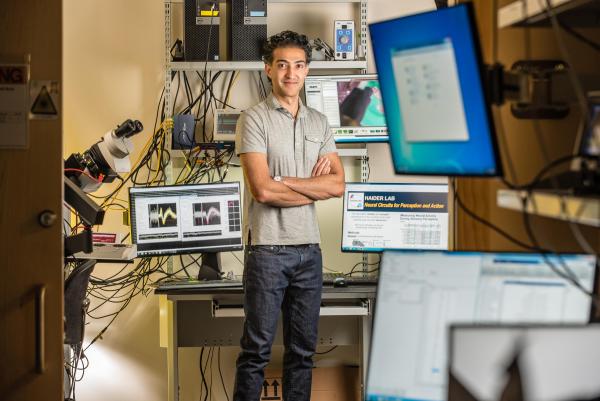You want to find a friend in a crowded sports stadium because he has your cell phone. He’s wearing a yellow ballcap and sitting in the upper deck, so your eyes scan the scene like a camera, filtering out all of the visual clutter and you quickly zero in on the bobbing yellow ballcaps at the top of the stadium. This kind of sensory perception is called spatial attention, and it allows you to selectively process visual information by prioritizing areas within your visual field.
“It’s a well-studied cognitive phenomenon – we anticipate a certain color or a certain feature in a particular region of the visual scene,” says Bilal Haider, assistant professor in the Wallace H. Coulter Department of Biomedical Engineering (BME) at Georgia Tech and Emory University, and a researcher in the Petit Institute for Bioengineering and Bioscience at Tech. “Attention allows your brain to focus and extract information from the scene very quickly.”
Haider and his team are investigating, at a very detailed level, the circuits and mechanisms involved in visual spatial attention, and they recently received a BRAIN Award through the NIH to support their research.
President Barack Obama launched the BRAIN Initiative (Brain Research through Advancing Innovative Neurotechnologies) in 2013, an international public-private research collaborative supporting the development and application of innovative technologies in an effort to produce a new dynamic picture of the brain that will show how individual cells and complex neural circuits interact in time and space.
The goal is to fill the gaps in our current knowledge and provide opportunities to investigate how the brain allows the human body to record, process, utilize, store, and retrieve massive amounts of information at the speed of thought. And Haider’s $2.1 million, five-year award, administered through the NIH NINDS, is the latest BRAIN Award granted to Georgia Tech researchers every year since the program’s launch.
Haider’s project is entitled, “Circuit and synaptic mechanisms of visual spatial attention.” Haider and his team, “are basically going to investigate in a very detailed way the circuits and mechanisms involved in visual spatial attention,” he says.
The role of attention in sensory perception is an important question in neuroscience, especially when trying to understand and create better treatments for disorders like schizophrenia, autism spectrum disorders, and attention deficit disorders. Haider and his team will utilize transgenic mice and combine high-density local field potential and neural activity recordings in the visual cortex, patch-clamp recordings from cortical and thalamic synaptic connections, cell-type specific optogenetics, and a well-characterized spatial attention task to elucidate the neural mechanisms of attention at multiple levels: specific cells, synapses, and circuits.
Haider’s BRAIN Award, which launched officially in the fall, will run for five years, through July 2023, and is valued at $2.1 million.
“We want to understand how circuits rapidly move attention this way or that way, turn it on and turn it off,” says Haider. “Once we can get a handle on that, we can really start to understand how we might be able to enhance normal attention and remedy attention deficits.”
This is just the latest NIH BRAIN Award for BME researchers. Haider’s department colleagues Garrett Stanley and Lena Ting are currently engaged in active BRAIN Initiative projects. Stanley’s third BRAIN Initiative project, entitled “Thalamocortical state control of tactile sensing: Mechanisms, Models, and Behavior,” was launched in January 2018 and runs through 2022. Ting’s project, “CRCNS: Multi-scale models of proprioceptive encoding for sensorimotor control,” began in 2016 and runs through May 2021.
Media Contact
Jerry Grillo
Communications Officer II
Parker H. Petit Institute for
Bioengineering and Bioscience
Keywords
Latest BME News
Jo honored for his impact on science and mentorship
The department rises to the top in biomedical engineering programs for undergraduate education.
Commercialization program in Coulter BME announces project teams who will receive support to get their research to market.
Courses in the Wallace H. Coulter Department of Biomedical Engineering are being reformatted to incorporate AI and machine learning so students are prepared for a data-driven biotech sector.
Influenced by her mother's journey in engineering, Sriya Surapaneni hopes to inspire other young women in the field.
Coulter BME Professor Earns Tenure, Eyes Future of Innovation in Health and Medicine
The grant will fund the development of cutting-edge technology that could detect colorectal cancer through a simple breath test
The surgical support device landed Coulter BME its 4th consecutive win for the College of Engineering competition.








